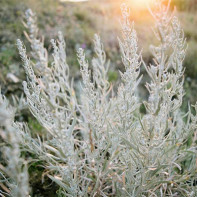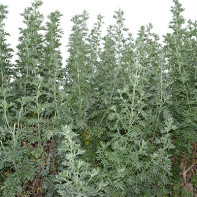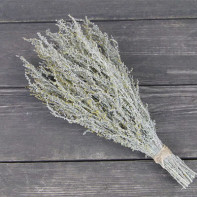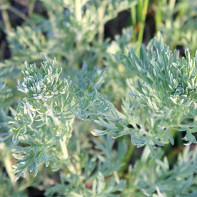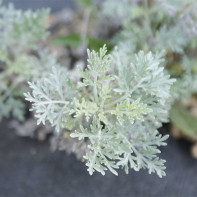Bitter wormwood: medicinal properties and contraindications
The famous wormwood smell is not to be confused with any other, its strong spicy aroma is able to repel insect pests, and the legendary wormwood bitterness from ancient times is in demand for the treatment of many diseases.
- Chemical composition
- What wormwood looks like and where it grows
- Types
- Gathering and storage
- Therapeutic properties of wormwood
- For Women
- For Men
- In Pregnancy
- For children
- For weight loss
- Mugwort in folk medicine
- For diabetes
- With pancreatitis
- For gastritis
- For the liver
- For kidneys
- For prostatitis
- For coughs
- For parasites
- From herpes
- For oncology
- From bronchitis
- Kinds of medicinal compositions
- Infusion
- Infusion
- Decoction
- Tea
- Oil
- Cosmetic applications
- Lotion
- Ice cubes
- Cosmetic oil
- Whitening mask
- Scrub mask for combination skin
- Mask for inflamed skin
- From acne
- Curative Mask
- Oily Skin Mask
- Alcohol Mask
- Facial Rash Mask
- Wrinkle Mask
- Rejuvenating Mask
- Infusion for Hair
- Decoction for Rinse
- Hair Growth Mask
- Dandruff Mask
- Contraindications for use
Chemical Composition
Such a fragrant smell of wormwood gives the essential oil. It is obtained by distillation. It has a blue or dark green color. The oil is thick in texture and contains a combination of substances. Thus, a group of terpenes is widely represented - cadinene, pinene, phellandrene, carotene and others, which have a beneficial effect on the digestive, musculoskeletal and other systems of the human body. It also contains other active ingredients (such as bitter glycosides anabsintin, absintin, ortabsin), which improve the function of the digestive tract. The essential oil also contains thujone, which has a toxic effect. Its presence makes you more cautious about consuming wormwood.
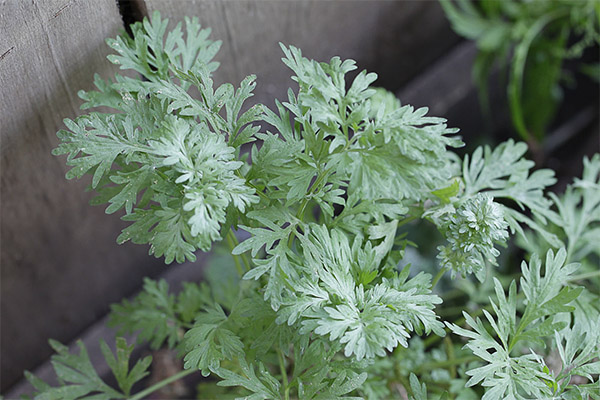
Vitamins are most represented by the A and E varieties that are able to remove toxins and carcinogens, stimulate cell renewal, and participate in most of the life processes of the body.
Also in wormwood there are organic acids - ascorbic, malic, succinic, thanks to which the normal acid-alkaline balance is maintained. Wormwood contains phytoncides and flavonoids, which can regulate a whole range of vital processes.
Thanks to its tannins, wormwood has the ability to eliminate the negative effects of pathogens.
Complete the picture of useful substances of wormwood saponins, capable of curing many diseases, since they have expectorant, diuretic, laxative properties.
What wormwood looks like and where it grows
Although wormwood is a herbaceous plant, it grows sometimes up to 2 m and looks more like a semi-shrub. Its root is taprooted, branched and can sprout up to 3 m deep into the ground. The shoots are erect, in general appearance from a distance the plant is green, with a gray-silvery patina, with which it is covered like a microscopic down.
Straight stems of wormwood are weakly ribbed, they are straight underneath and begin to branch closer to the top. The leaves vary in shape and how they are attached to the stem. The lower ones sit on long petioles, and are double- and triple-pinnately dissected in shape. The middle leaves are attached by short petioles, and all of them are pinnate, dissected twice. The uppermost ones, without petioles, are attached directly to the stem, so they are called sessile. These leaves are also pinnate and split.
The wormwood that is found in nature has small yellow flowers, while the ornamental varieties may have large flowers in shades of pink and crimson. The flowers are so small that even a basket-shaped inflorescence composed of them does not exceed 3.5 mm in diameter. The flowers are arranged in clusters. In the European part of Russia, wormwood flowers in June and July, and then in August the seeds ripen, which are oblong pointed achenes only about 1 mm long.
Wormwood tolerates frost and drought well, so the geography of its distribution is large: it grows in Europe, North America, North Africa, and the western part of Asia. In Russia, it occupies the entire territory of the European part of the country, from the northern to the southern seas. Soils with neutral acidity and moderate moisture suit it best, and it feels good in vegetable gardens and in the fields. Meadows, fallow lands, edges of woods, roadsides, and residential areas - wormwood can be found everywhere. It is also grown as a crop, not only in Russia, but also in the United States, in the south of Europe and in the north of Africa. The plant material is used to make oil.
Varieties
In nature there are over 200 different species of wormwood, among them there are high-growth and low-growth.
The taller species are
- Wormwood bitter. The most common species in the middle belt of Russia. This perennial is characterized by a pronounced smell and a bitter taste.
- Artemisia rutifolia. This prairie plant is found in Central Asia and in Western and Eastern Siberia. It can reach a height of 80 cm.
- Gmelin's wormwood. A herbaceous plant that can reach a meter in height. It has fairly sturdy erect stems, usually woody underneath.
- 1) Louisiana wormwood. This wormwood usually blooms in August and is so ornamental that it is even used by gardeners and landscapers to decorate aromatic or spicy beds and flowerbeds.
- Wormwood is an annual. Externally and by smell similar to the perennial. It differs from it only in its root system: the perennial has buds on its roots, while the annual has no buds. It grows mainly in the arid regions of Central and Eastern Asia, as well as in the south and southeast of Europe.
- Artemisia milfoil. Quite a large plant, this perennial can reach 2 m in height. This species is liked to use for decorative purposes in landscape design, as well as to decorate borders and mixborders or to plant in the same row with currants: and beautiful, and pests do not disperse.
- Field wormwood. The plant is perennial, reaching a height of 80 cm. The stems are reddish, slightly pubescent, and the leaves are green, thin and flat. Occurs in Western Siberia as well as in Central Asia, its favorite places of growth are glades, edges, meadows, steppes, roadsides.
Species are stunted.
- Schmidt's wormwood. The height of this perennial is only 20 cm. It finds practical use in homestead floriculture, because it is very decorative: the leaves are silvery, strongly dissected. They are planted as a border, decorate alpine slides, shade roses in flowerbeds.
- Mugwort cold. A plant with pale green leaves, grows up to 40 cm in height, the flowers are yellow or pink-purple. Favourite habitats include steppes, pine forests, terraces and rocky slopes in Central Asia and northern China.
- Steller's wormwood. A bright beautiful plant with soft silvery openwork leaves. In the natural environment it is found in Norway, Japan and the Far East. This decorative flower is used to decorate gardens. It looks very effective in combination with bright flowers on alpine slides, natural terraces and retaining walls.
- Wormwood glistening. In nature occurs in the southeast of the Alps. The leaves are characterized by a silvery patina and a rather intense peculiar smell. They are thin, narrow and flat. The plant is low and has also found use in decorative landscaping - to frame floral compositions.
Gathering and storage
Wormwood is harvested twice during the summer, depending on what medicinal raw material is required. The leaves are cut off before the plant enters flowering. The leaves are harvested from both sessile and petiolate leaves, but the petioles are not taken, only the leaf plate is needed for medicinal purposes.
Later, when the wormwood has formed buds, it is time to cut off or snip off the flowering tops. Do not wait until the buds open later - dried flowers will lose their yellow color and turn brown, the plant will have reduced medicinal value. Inflorescences are cut to a height of 20-25 cm.
Medicinal plant gather on a sunny day, when the dew has descended, and it is better to hurry up and do the job in the morning.
Mugwort is spread out to dry on paper in a loose layer (no thicker than 5 cm) in a well-ventilated place - on the porch, terrace or attic. For faster drying, from time to time the grass is stirred up. If the stems began to break - then the raw material is ready.
Dried herbs stored in cloth sacks, plywood and wooden boxes or glass jars under tightly closed lids. Maximum shelf life - 2 years.
Therapeutic properties of wormwood
The medicinal properties of wormwood are recognized not only by folk medicine, but also by official medicine. This medicinal plant is included in the pharmacopoeia of more than 20 countries, in particular it was included in the pharmacopoeia of the USSR.
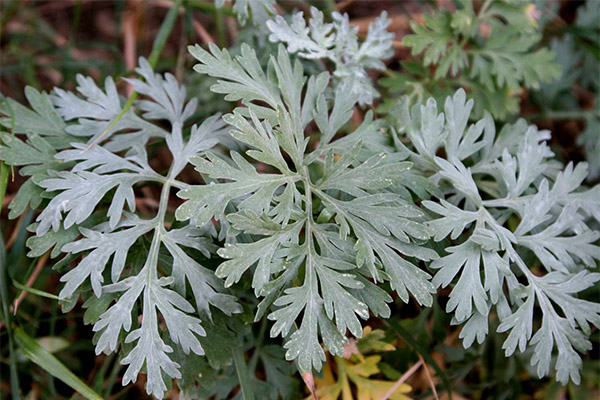
The plant is used to prepare liquid compositions - water infusions and alcohol tinctures, extracts and decoctions, oil and teas. Wormwood bitterness is used to improve digestion and appetite, and enhances the secretion of bile and pancreatic juice. It is used internally as a remedy for liver and biliary tract diseases, gastritis, diarrhea and dysentery, heartburn, ulcerative colitis, hemorrhoids, jaundice, and to get rid of worms. Wormwood is recognized as effective for metabolic disorders, obesity, diabetes, anemia, edema, hypertension and migraine. As an expectorant and anti-inflammatory, wormwood is used for colds, bronchitis and even pulmonary tuberculosis.
Outwardly, wormwood is used for its hemostatic, anti-inflammatory, analgesic, and wound-healing properties. Wormwood is used in compresses, lotions and applications to treat purulent wounds and ulcers, allergies, bruises, as well as to relieve sprains and strained ligaments.
For women
Wormwood is quite widely known in gynecology. Women use its ability to reduce overly abundant menstrual discharge, to eliminate pain during this period. In addition, this medicinal plant helps to normalize the hormonal background, in connection with which it can be used in the treatment of infertility, fights genital infections, as well as prevents the emergence of malignant uterine tumors.
To eliminate menstrual pain, it is sufficient to take a couple of drops of mugwort alcohol tincture before meals. The same remedy is used for uterine myoma, but 1 teaspoon at every breakfast and dinner for two weeks. After a 30-day break, take another course of treatment.
For men
As a remedy used to improve male health, wormwood has been known since ancient times. And its effectiveness has been proven both in the treatment of infectious diseases of the male genital sphere, and for the relief of prostate adenoma and prostatitis. With the latter problem, the anti-inflammatory ability of the medicinal plant works, thanks to which the outflow of urine improves, making it easier to urinate and reducing pain.
The wormwood-based compositions contribute to improving blood circulation in the pelvic organs, this allows them to be used to treat impotence as an aid. It is also beneficial in the treatment of alcohol addiction, as well as in the treatment of alcohol poisoning and hangover syndrome.
Pregnancy
But pregnant women should not take wormwood compositions. Firstly, because it is a strong laxative. Secondly, you should not forget the large amount of essential oils contained in wormwood. They can provoke a serious allergy in the unborn child. Thirdly, although traditional healers have prescribed mugwort during pregnancy, the purpose of their prescriptions was not to save the baby, but to cause a miscarriage. This is a serious risk for the mother-to-be, especially in the early stages of pregnancy.
In addition, pregnant women can not be remedies from mugwort, since the plant contains thujone, which is essentially almost poison.
For children
Alcoholic tincture of wormwood is categorically contraindicated for children, because it is infused with alcohol.
Teas and decoctions from coughs can be taken by children, but with great caution and only after consulting a doctor. In addition, the dose should be three times lower than for an adult, you can take the decoction only 1 teaspoon before a meal.
When losing weight
In losing weight, the main thing is to establish metabolism, get rid of all the unnecessary things that the body has accumulated: toxins, salts and other harmful deposits. Wormwood will help to carry out such a necessary cleansing. You can try to use wormwood oil, for which you drink 1 tablespoon of the product 3 times a day for 20 minutes before meals. If you take it regularly for two weeks, the weight will decrease, the metabolism will come back to normal, digestion and stools will improve.
Mugwort in folk medicine
In folk medicine, decoctions of wormwood have long been used for various diseases, especially for coughs. Even a lotion made on a decoction of wormwood, put on the forehead, can eliminate insomnia.

For Diabetes.
Because wormwood contains the insulin-like substance inulin, this plant is useful for diabetes. When inulin enters the digestive system, it binds glucose that enters the stomach and intestines with food. As a result, glucose does not enter the circulatory system; accordingly, the need for insulin in humans is drastically reduced. Inulin works in different dosage forms: tinctures, decoctions, teas, even in powder, which is ground dry mugwort.
- The powder is for diabetes. It is necessary to make a depression in the crumb of black bread, pour into it crumbled into a powder dried wormwood herbs. Roll a ball of bread, rolled in it a medicinal plant, and eat it at lunch. Continue such treatment for 2 weeks. You can pour such powder into the morning porridge, cooked in water and milk.
- Juice with wine for diabetes. Narrow 2.5 kg of wormwood, wash it, dry it with a paper towel and twist through a meat grinder or break it with a blender into a pulp. From the resulting mass to squeeze the juice should be about 300-400 ml. In the resulting juice add 2 liters of slightly heated, warm wine "Cahors". Stir and pour into dark glass bottles. Store the wine with the juice in the refrigerator. Take this remedy in three-day courses of 20 ml in the morning and evening. Then take a break for 3 days and repeat the treatment again. In general, the course is a month.
In pancreatitis
Doctors caution: patients suffering from pancreatitis, do not drink wormwood-based remedies during periods of acute disease, that is, during the pain in the pancreas. At this moment, the organ needs maximum calmness. When the acuteness of the attack is relieved, it is necessary to consult with a doctor about what scheme and what remedy to take.
- Infusion for pancreatitis. It takes 1 tablespoon of freshly harvested wormwood leaves or 0.5 tablespoons of dried medicinal raw materials. Pour mugwort with a glass of boiling water and cover with a lid or saucer so that the essential oils do not escape. Let the infusion stand for half an hour, then strain and take 3 times a day for half an hour before meals.
- Decoction for pancreatitis. Proportions - as in the previous recipe: per glass of water - 1 tablespoon of fresh leaves or 0.5 spoons of dried raw materials. The herb, poured hot water, put on a low heat for 20 minutes. Remove from the heat, and when it cools, strain. Sweeten the decoction with 2 teaspoons of honey and take the same scheme as the infusion: 30 minutes before a meal 3 times a day.
- Powders for pancreatitis. Grind dried wormwood herb in a mortar. Mix the resulting powder with sage powder, obtained in the same way. Take five parts of sage for one part of wormwood. Take ready-made powder, 1 teaspoon three times a day for half an hour before a meal. Drink boiled water.
- Phytoset for pancreatitis. Wormwood is such a bitter herb that not everyone has the guts to take it for several weeks. To mute the bitter taste and enrich the broth with additional useful properties, you can prepare a collection of several herbs. Take 1 tablespoon each of wormwood, St. John's wort, chamomile, calendula flowers, sage, succession, horsetail, wheatgrass, roots of elecampane and burdock. Mix all the dried and ground herbs in a large glass jar, close screw-cap. In the morning make a glass of boiling water 1 tablespoon mixture of herbs, to insist 15 minutes, then strain and divide into three portions to be drunk during the day - in the morning, at lunch and evening. The course of treatment - two weeks.
With gastritis
To reduce the acidity of gastric juice, you need to prepare an infusion of a mixture of herbs. This remedy will increase the appetite and improve the work of the digestive tract.
Take in equal parts wormwood, yarrow, mint, chamomile, sage. Mix the raw materials and grind in a mortar. Pour 1 tablespoon mixture with a glass of boiling water, cover and infuse for about an hour. Strain and drink once a day.
For the liver
- Infusion with wormwood and juniper. It is necessary to prepare equal parts of dried herbs of sage, wormwood and juniper. Stir, crush. Take 4 tablespoons mixture and pour 1 liter of boiling water. Insist under a closed lid for at least an hour. Strain, divide the resulting liquid into 3 portions and drink it in 3 portions during the day. Recommended for liver problems and gall bladder disease.
- In chronic inflammation of the liver. Mix in equal quantities the herb yarrow, wormwood, mint, fennel fruits, dill seeds and immortelle flowers. Take 2 tablespoons of the mixture, pour 0.5 liters of boiling water and put on a water bath for 15 minutes. Remove from the heat and infuse for another ¾ hour. Strain, take a half glass for a quarter of an hour before a meal 4 times a day.
For the Kidneys
Among folk healers, wormwood is considered one of the most useful plants for people suffering from kidney disease. Its diuretic effect and ability to remove stones help in their treatment, which is used by the pharmaceutical industry to make medicines.
Syrup for Kidney Treatment
This syrup is so effective in saving kidney cramps, eliminating stones and sand, that herbal healers call it a miracle syrup.
Pour 3-4 tablespoons of raw materials with water, leave for a day to insist. Drain the liquid through gauze and bring it to a boil over low heat. Add a glass of sugar or honey and boil the contents to a thick consistency. As it cools, you can start taking it. Drink 3 times a day for 15 grams without reference to the time of the meal.
Decoctions for pyelonephritis
This remedy helps in that it reduces pain in the kidney area.
Mix 2 tablespoons each of dried wormwood, blueberry and lavender herbs, 1 tablespoon of willow bark, 4 tablespoons of chamomile. The amount of water is calculated as follows: 10 g raw materials - 100 ml of water. Boil the herbs on low heat for about 15 minutes, then cool the decoction and strain. Boil again, let the broth cool and start using. In the first month to drink 3 cups of broth per day, the next - twice a day to 200 grams. On the third month, the rate is reduced to taking one glass of the healing composition on an empty stomach.
If only one kidney hurts, only compresses are enough: soak a cloth in the decoction and make a compress with it on the side of the lower back where it hurts.
For prostatitis
Most often, mugwort-based infusions are used to treat prostatitis.
- Mix one part of the wormwood inflorescence and two parts each of the herb of the mountain pepper, horsetail, leaves of hazelnut-wood and three parts of chamomile. The mixture of herbs (1 tablespoon) pour boiling water (one glass) and leave for an hour to infuse. Strain and take half an hour before a meal 3 times a day.
- Wormwood inflorescences (1 tablespoon) pour boiling water (glass) and infuse for an hour. Strain and divide into 3 parts. Drink during the day for half an hour before a meal.
- Take 100 grams of dried yarrow herb, wormwood and pine buds. Stir the vegetable raw materials, pour 1 liter of warm water and place on a low heat, boil for 2.5 hours. Remove from the stove and leave to infuse for 24 hours, then strain and add 50 g brandy and a glass of fresh aloe juice. Sweeten with 1 tablespoon of honey. Take 1 teaspoon 3 times daily, regardless of meals.
For coughs
Wormwood is also effective for coughs and colds, and a tincture can be used in alcohol.
Pour 200 ml of alcohol with 2-3 tablespoons of crushed wormwood leaves, preferably freshly picked, but you can also use dried raw materials. Warm the composition in a water bath for about 20 minutes. Remove from the water bath, dissolve in tincture 1 teaspoon of honey and leave to infuse for 12 hours, then strain.
Take 2 tablespoons in the morning and at night. You can snack on this remedy with fruit to discourage bitterness.
From parasites
To cleanse the intestines and get rid of parasites, you need to prepare a special infusion, with wormwood and garlic, which is then used with an enema.
- Solution for worms. 1 tablespoon with a handful of crushed wormwood pour a glass of boiling water and insist an hour. Meanwhile, squeeze half a cup of garlic juice. Strain the wormwood infusion, add to it the juice of garlic. The composition for the enema is ready!
- Tea from worms. To expel round parasites, herbalists prescribe 10 days of wormwood tea. Prepare it simply: 1 teaspoon of dry raw materials pour a glass of boiling water and take 3 tablespoons in the morning and evening.
- Worm powder. Grind in a mortar or coffee grinder 100 g of dried wormwood. During the first three days, every 2 hours to take 1 teaspoon of the resulting powder and drink water. On subsequent days, the interval between doses increase. Take the whole powder in a week. Such a method of treatment is recommended to use 2 times a year, especially for those who are in close contact with animals - works with them or contains in the farm.
From herpes
Boil with steep boiling water 1 tablespoon of dried wormwood raw materials. Cover with a lid and wrap to infuse for 3 hours. Strain and rub this infusion herpes ulcers on the lips. You can stick a piece of steamed leaf and hold it on the sore spot. Advised to use the infusion as a tea 2 times a day, if desired - with honey.
When oncology
Bitter wormwood tincture gives the body the strength to fight a serious illness, neutralizes free radicals in the human body, cleanses the liver of toxins, which is especially relevant if the patient is undergoing chemotherapy treatment. This remedy can only be used as a supportive measure in addition to the main treatment prescribed by the doctor.
Prepare 5 grams of dried wormwood herb and 50 g of rose hips and yarrow herb. Pour 3 liters of steep boiling water and leave to stand for 2 hours. Then put on a water bath and simmer for 2 hours. Remove from the heat, wrap for warmth in a towel and insist a day. Then pour into the infusion 200 grams of dry powder extract fungus and put two handfuls of finely chopped aloe leaves. Enrich the infusion with a glass of brandy and 3-4 tablespoons of honey. Take 1 tablespoon of the healing agent before each meal.
When bronchitis.
From wormwood can be made a variety of remedies for the treatment of bronchitis: decoctions, teas, infusions, inhalations.
- Decoction for bronchitis. The remedy prepared according to this recipe is effective not only for bronchitis, but also for lung diseases. Pour 300 ml of cold water 1 tablespoon of dried wormwood. Put on the fire and boil for 3 minutes. Remove from the fire and infuse 45 minutes. Strain and drink during the day, dividing into 3 drinks. Drink for 15-20 minutes before a meal.
- Tincture with a dry cough. Pour 0.5 ml of good vodka 20 g of dry wormwood raw materials. Let it stand for at least one day in a dark place at room temperature. Take 3 times a day, 1 tablespoon. Drink before meals and at night. If you add honey to the tincture (2 tablespoons), it will be effective for very severe bronchitis with a clogging cough. Take according to the same scheme. The cough will begin to give up sharply on the second day of taking it.
- Cough infusion without alcohol. This remedy also works great for bronchitis. Unlike the tincture on alcohol, it can be given to children. You need 40 g of herbs pour a glass of boiling water and, having covered with a lid, insist for an hour. Strain and drink 3 times a day with a tablespoon, add honey.
- Inhalation with oil for coughs. For inhalations with bronchitis will go not a homemade oil extract, but wormwood essential oil, which you can buy in the pharmacy. If there is a special inhaler, you can drop 1-2 drops of essential oil into it and breathe. If you do not have an inhaler, you can put 3-5 drops of medicinal oil in hot water and breathe by bending over the container and covering your head with a towel.
Types of medicinal compositions
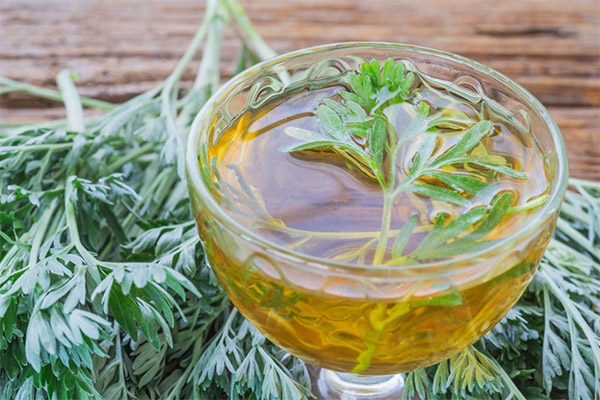
Infusion
Infusion should be prepared in the volume that is needed for the day, because it is not intended for long-term storage. For a daily portion of the medicinal composition is enough 2 teaspoons of powder of dried wormwood leaves. Pour them with a glass of boiling water, cover tightly. After 20 minutes, strain and drink.
Tincture .
Tincture works well in the complex treatment of coughs, colds and SARS. But this remedy is prohibited for children, since it contains alcohol.
To obtain the tincture, you need 2 tablespoons of crushed wormwood leaves pour in a glass dish a glass of quality vodka, shake and send to a water bath for 20 minutes. Remove from the heat and leave for further infusion for 6 hours, then strain, squeeze the herb, and the resulting tincture pour into a bottle, cover it and put in the refrigerator.
Decoction
To prepare a decoction according to the classic recipe, you need both dry raw materials and fresh leaves. Dried wormwood needs 0.5 tablespoons, raw crushed leaves - full. Pour a glass of hot water and put on the fire. As it boils, simmer over low heat for 20 minutes. Remove from the heat, and when it cools, strain.
Decoction according to this recipe normalizes the metabolic process.
Decoction of dried herbs
The remedy for hemorrhoids is prepared from dried wormwood, and then used in the form of an enema.
To prepare a healing decoction, you need to pour 1 liter of water 4 tablespoons of the herb, bring to a boil and boil for 7 minutes over low heat. Remove from the fire, wrap for warmth in a towel and insist about 6 hours. Before use, strain.
Broth of wormwood root
Pour into hot water, dried and crushed wormwood root (2 tablespoons). Boil for 10 minutes under a lid so that the essential oils do not escape. When it cools, strain the decoction and drink throughout the day, taking 2 tablespoons at a time - 30 minutes before a meal. This composition is effective for cancer of the digestive and reproductive systems, as well as an anthelmintic.
Tea
To boost the immune system, it is recommended to drink tea with wormwood. To do this, you need to brew an ordinary favorite green tea in a kettle. In another pot, pour 1 teaspoon of wormwood with half a cup of boiling water. Wait 5-7 minutes, filter the wormwood infusion and pour it into the teapot with the tea. Let it stand together for another 5 minutes, and then you can drink it. The herbal aroma of green tea with a subtle bitterness of wormwood is so delicious! You can add sweetness with sugar or drink it in a bite with honey.
Oil
You can make wormwood oil at home. Of course, this will not be the same essential oil that is sold in the drugstore, it is made with special equipment and with the appropriate technological processes. But to get a useful oil concentrate of wormwood on your own is quite possible.
For homemade oil, pick a half-liter jar of fresh wormwood leaves, there is no need to crush the leaves on purpose. Then pour the leaves completely with olive, sunflower or linseed oil, cover the jar with a screw cap. Insist at least 2 weeks, during this time the useful substances from the leaves to the oil, it becomes dark green. When it turns green it's ready. You can strain and put in the fridge to then use as needed, to treat sores and ulcers.
Cosmetic applications
Due to the fact that mugwort contains many mineral complexes, vitamins and organic acids, it is widely used to put in order the skin of the face: eliminate peeling, inflammation, fight acne, rejuvenate and smooth the skin. In order to make women beautiful, wormwood is used to make lotions, lotions, oils, tonics, cream, decoctions and ice cubes based on it, tinctures and masks. The most commonly used wormwood for cosmetic purposes is common bitter, famous for its anti-inflammatory and antibacterial properties.
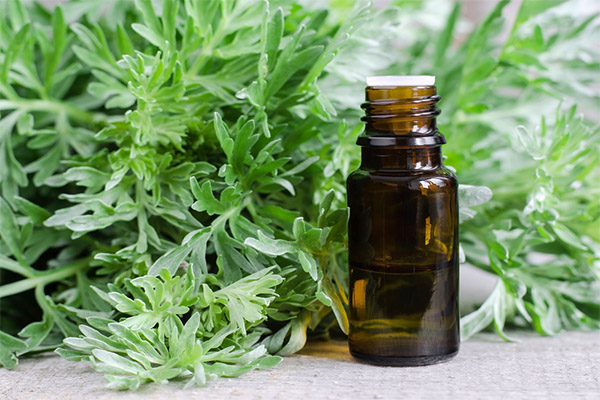
For the face wormwood works as follows: normalizes the sebaceous glands, drying up excessively oily skin, removes redness and inflammation, eliminating pathogenic microflora, gets rid of acne and acne, stimulates metabolic processes and cell renewal, brightens and removes pigment spots.
Means based on this plant are suitable for use with different types of skin, but most often it is used with oily and prone to acne formation. Its effectiveness in this case is provided by the disinfecting components. For this reason, they are also used to treat skin conditions such as psoriasis, eczema, dermatitis, urticaria, demodicosis and diathesis.
Before applying the wormwood-based composition, you need to check the individual reaction of the body to the components, for which purpose, apply the product to the inside of the elbow or wrist for 25-30 minutes. If no redness or peeling remains, you can use mugwort for a beauty treatment.
Lotion
To prepare the lotion, mix 1 teaspoon of mugwort alcohol tincture with 300 ml of mineral water and 20 drops of almond oil (you can buy it at the drugstore). Pour the finished product into a glass bottle with a screw cap and store the lotion in the refrigerator. Rub it on your face in the morning and evening after washing, then it is recommended to apply moisturizing cream.
Such a product promotes deep cleansing of pores, nourishing the skin with vitamins, minerals and trace elements. Thanks to its use improves blood circulation, restores skin tone, aligns its structure, refreshes the face.
Ice cubes
Ice cubes prepared with decoction of medicinal herbs are wiped over the face, which allows to remove acne and inflammation, relieve redness and normalize the skin color, tighten pores and "invigorate" the skin. In addition, the cold perfectly "trains" blood vessels, making them more elastic. Treat your face after washing. This method is especially useful in the treatment of acne and demodex. For the best effect, a course of 7-10 such procedures is necessary.
Cosmetic oil
Pour 1 tablespoon of crushed fresh wormwood leaves in 100 ml of oil - you can take olive, sunflower or linseed oil. Insist at least 3 days in a glass dish at room temperature in a dark room. Strain it and you can use it.
Add a few drops of the resulting oil in a cream, which is usually used for morning facial care. In the evening, you can apply the oil to the face in its pure form, without cream.
This oil is suitable for ladies with any type of skin. It helps with rejuvenation, softens the skin, makes it firmer, smoothes small wrinkles.
whitening mask
Such a mask will help to brighten the face, remove pigmentation of mature skin, discolor freckles. It is good to use this remedy before a trip to the sea, so that the tan is even.
Grind 1 tablespoon each of oat flakes and wormwood in a coffee grinder and pour 50-60 ml of green tea in portions. Mix to a paste consistency and add to the paste 1 teaspoon of lemon juice. Apply the remedy to the face, especially carefully work the pigmented spots. Let the mask lie on the skin for about 15 minutes. During the month before vacation do this procedure 4-5 times.
If the skin is dry, use sour cream, fat milk or cream instead of tea. The resulting paste is put on the face for 20 minutes.
Scrub mask for combination skin
Face steamed with a hot towel: dip it in hot water, wring it out and put it on the chin, cheeks, forehead. Lie for 5 minutes until the towel cools down. Repeat the procedure one more time and again wait for 5 minutes. Then take the dried and crushed wormwood herb and apply it to the face, gently massaging the skin. Wormwood acts as a mild abrasive, cleanses the skin of old cells, deep impurities, and stimulates the process of skin renewal.
Mask for inflamed skin
First you need to prepare an infusion of wormwood, for which 1 tablespoon of plant raw materials pour 100 ml of hot water. Once infused (30-40 minutes), strain, and vegetable porridge mixed with 2 tablespoons of sour cream and put on your face. Wash your face after 15 minutes. If you apply the mask regularly - once a week, it will not only reduce inflammation, but also contribute to whitening the skin.
From acne
Wormwood's ability to eliminate inflammation is in demand in masks for the treatment of various skin problems.
Add 1 tablespoon of badyaga powder (you can buy it at the drugstore) with a little mineral water, stir it to get a liquid sour cream, and leave it to infuse for 10 minutes. Mix 1 teaspoon of wormwood juice with the same amount of chamomile and add to the composition of badyaga. The resulting remedy to put on a cleansed skin for 18-20 minutes.
Use such a mask once a week, in total the course of treatment should be 5 to 7 days.
Curative mask
Make a decoction from the leaves of wormwood: for 10 minutes, boil 2 tablespoons of dry crushed raw materials in 2 cups of boiling water. Cool down and strain. Make a paste of 50-70 grams of oat flakes, adding a little decoction. Apply the paste on your face for 15-20 minutes.
Do not pour out the rest of the broth. It can be rubbed on the skin in the morning to tone it and make it look fresh.
Mask for oily skin
Boil 1 tablespoon of dried wormwood in a glass of water for 10 minutes. Let cool, then strain. Beat an egg white and mix it with the broth. Apply on your face for 20 minutes. It will help to eliminate oily shine, cleanse and narrow pores, tighten the facial oval.
Alcohol mask
Take 2 teaspoons of alcohol tincture of wormwood, mix it with 1 tablespoon of honey. Apply to the face with a cotton pad for 30 minutes. Rinse with warm water.
Mask for rashes on the face
Grate the top yellow part of the lemon skin - the zest. For the mask you will need 20 g (about 2 teaspoons) of zest. Mix it with 50 g of leftover oatmeal with milk from breakfast and 50 ml of wormwood broth. Place the mixture on your face for 20 minutes. Repeat this procedure twice a week, treatment duration is one month.
Anti-wrinkle mask
Mix 1 tablespoon of dried wormwood with 2 tablespoons of sage and pour a little hot water to make a paste. Mix it with 10 g (or 2 teaspoons) of cottage cheese and chicken egg yolk and massage it onto your face, before cleansing it.
Wash off after 15-20 minutes, and wipe your face with an ice cube made from wormwood decoction. The greatest effect can be achieved if you do such a mask every 4-5 days, you will need a total of 7-8 treatments.
Rejuvenating mask
This mask has anti-aging properties, since it includes antioxidant components.
To prepare it, you need to mix dried wormwood raw material with St. John's wort, mint, chamomile, mother-and-mother, and sage. Take 1 teaspoon of wormwood, the other herbs - 2 teaspoons each. Pour the herbal mixture with hot water and infuse for 20-25 minutes. Strain, put the decoction in the refrigerator to use later for morning washing, and the steamed herbal mixture mixed with 1 teaspoon of sour cream and spread on the face. After 15-20 minutes, wash your face. In winter such a mask should be done a couple of times a week, in summer - once.
Infusion for hair
To improve the scalp and reduce its greasiness, you can rub in wormwood infusion: 2 tablespoons of dry herbs pour a glass of boiling water, cover with a lid, wrap with a towel and insist 10-12 hours, and then rub into the skin under the hair, do not wash off. You can repeat this procedure twice a week. In addition to reducing greasiness, it will help get rid of dandruff and severe hair loss.
Decoction for rinsing
Decoction will help to get rid of itchy scalp, strengthen the hair and slightly mask the individual gray hairs.
1 tablespoon of crushed dried wormwood, pour a glass of boiling water and boil for 5 minutes over low heat. Cool, strain, and dilute with 1 liter of water. Rinse your hair after washing it.
Hair growth mask
Pour 2 tablespoons of the herb 200 ml of beer and heat the composition in a water bath for 15 minutes. When it cools so that you can bear it, apply it to the hair with massaging movements, wrap the head with a towel for half an hour, then rinse. Such a mask will not only strengthen the hair follicles, but also accelerate their regrowth.
Mask for dandruff
Mix until smoothly 1 tablespoon of wormwood broth, egg yolk and 15 grams of honey. Smear this mixture on hair and skin under hair, wrap head in clingfilm and wrap with a towel. Hold the mask on your head for half an hour, then rinse. This remedy will help get rid of dandruff of any type.
Contraindications for use
Pregnant women in any case can not any compositions based on wormwood: you can at best get an allergy in the future child, but what is worse, it is fraught with miscarriages. Expectant mothers are not forbidden to walk in the fields and breathe herbal smells, including inhaling the bitter scent. Mugwort is contraindicated for women who are breastfeeding their babies. Children compositions based on wormwood can be given with great caution and only after consulting a doctor.
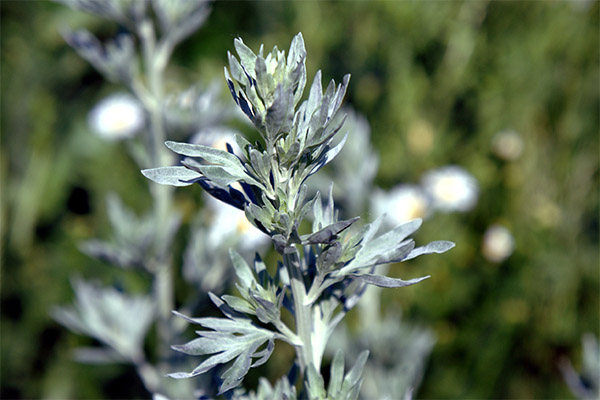
Direct contraindication for mugwort is stomach ulcer and duodenal ulcer, gastritis with reduced acidity, and diseases of the digestive system during exacerbation.
Do not take the compositions on the wormwood in case of thrombophlebitis. If you find an individual intolerance to the body, it is better not to take this medicine.
Since in an overdose wormwood is capable of causing visions and uncontrollable muscle tremors even in a relatively healthy person, those who suffer from diseases associated with mental disorders, as well as serious diseases of the nervous system, the reception of the herb inside is generally contraindicated.
Overly strong herbal remedies may affect obese people of advanced age.
However, anyone who is not allowed to use mugwort internally can be treated with external remedies - apply applications, compresses, and lotions.
In an overdose of wormwood can cause severe pain and dizziness, quite possible nausea up to vomiting. Weakness and lethargy up to loss of consciousness, auditory, visual and tactile hallucinations, as well as convulsions and convulsions - such manifestations of overdose also occur.
«Important: All information on this site is provided for informational purposes only. purposes only. Consult a health care professional before applying these or other recommendations. specialist before using any of the recommendations. Neither the editors nor the authors shall be held liable for any possible harm caused by materials."

